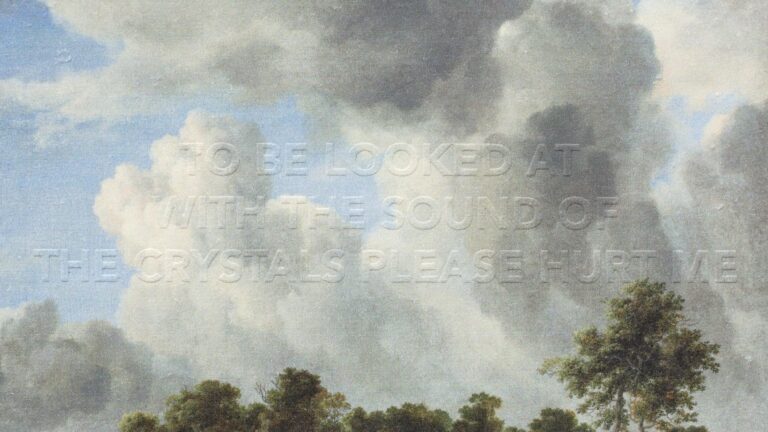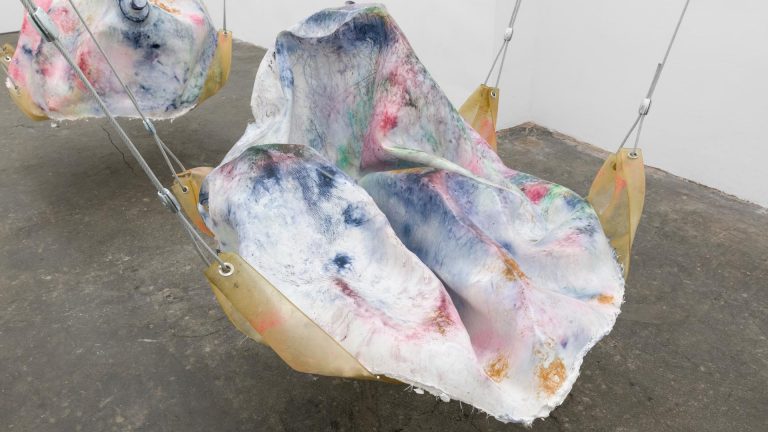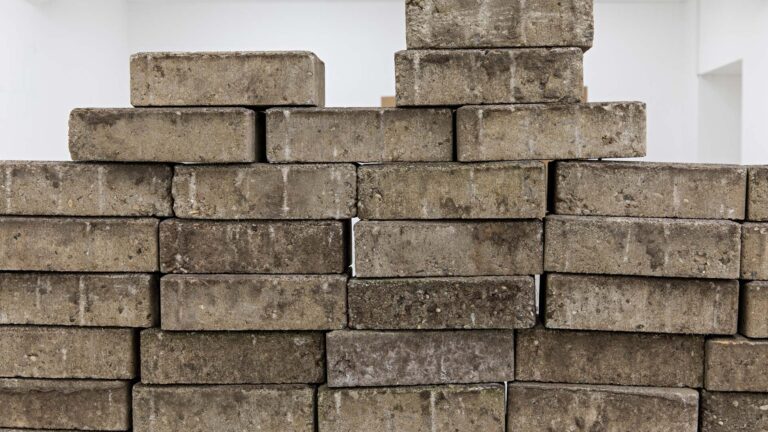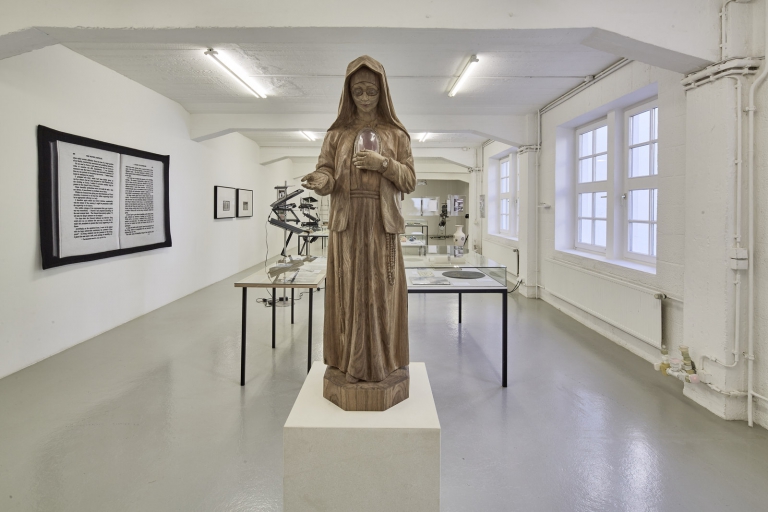Artists: Carla Åhlander, Louise Ashcroft, Simon Blanck, Christoph Draeger, Kasia Fudakowski, Anna Gohmert, Annemarie Goldschmidt, Teal Griffin, Harry Haddon, Ethan Hayes-Chute, Lars-Erik Hjertström Lappalainen, Per Hüttner, Nina Katchadourian, Alex Kwartler, Karin Kytökangas, Keith Larson, Mathias Lempart, Dafna Maimon, Marit Neeb, Laura Pientka, Sascia Reibel, John-Luke Roberts, Xavier Robles de Medina, Lydia Röder, Ruth Rubers, Maxwell Stephens, Anna M. Szaflarski, Nala Tessloff, Jana Thiel, Olav Westphalen, Gernot Wieland
Exhibition title: The Palliative Turn
Curated by: Nadja Quante in close collaboration with Kasia Fudakowski and Olav Westphalen
Venue: Künstlerhaus Bremen, Bremen, Germany
Date: July 9 – October 3, 2022
Photography: all images copyright and courtesy of the artists and ©Künstlerhaus Bremen
The Künstlerhaus Bremen is pleased to host the Association for the Palliative Turn as part of its 30th anniversary under the title The Palliative Turn.
The Palliative Turn is a collaborative and interdisciplinary project that spans across an exhibition, a program of events and a magazine to be launched at the finissage. The project brings together contributions from artists, designers, a kinesiologist, a philosopher, a comedian, a grief and death counsellor, and a climate scientist amongst others, who have all entered into an exchange within the framework of the Association for the Palliative Turn (APT). Founded in 2020, APT is an open-ended collaboration dedicated to discussing and promoting a palliative approach to, and in the arts. With an experimental, speculative and humorous approach, APT applies the concepts and methods of palliative care to the current crises of civilization, viewing the period before systemic collapse as a time of insight, growth, and profound joy in all that is left. APT proposes no quick fix solutions, but an acceptance of the finitude of life and the limits of our remaining possibilities. What role can art take on as we head toward the inevitable end?
The Palliative Turn brings together more than 30 contributions from different practices, some of which will be on view in the exhibition, some of which will appear in a magazine, or will take place in the accompanying program of events. In the gallery of Künstlerhaus Bremen, Kasia Fudakowski presents the process and results of a palliative assessment of the institution, Künstlerhaus Bremen. Dafna Maimon and Ethan Hayes-Chute show a new collaborative work that addresses saying goodbye. Other works address themes of cycles, limitations, and inscriptions that we are confronted with. The exhibition extends beyond the exhibition space into the courtyard of the Künstlerhaus and the public space: for example, Alex Kwartler will show a poster work in the neighbourhood of the Künstlerhaus Bremen, while the courtyard of the Künstlerhaus will feature a work by Mathias Lempart, created in collaboration with grief and death counselor Lydia Röder.
The Palliative Turn will be accompanied by public events such as performances, a Last Aid workshop with Lydia Röder, palliative drawing sessions with Olav Westphalen, a cemetery walk with Jana Thiel, and a palliative dinner. Kinesiologist Annemarie Goldschmidt will give a Health and Cell Death Workshop together with artist Per Hüttner. In her workshop No Kids, artist and comedian Louise Ashcroft invites us to reflect on what it means not to have children and foresake a genetic legacy.
The Association for the Palliative Turn network continues to expand. With Laura Pientka, Ruth Rubers, Jana Thiel and Nala Tessloff, students and graduates of the Hochschule für Künste Bremen are also involved. Exchanges between participants are an important aspect of the project. New collaborations resulting from the process in Bremen will find their way into the Association for the Palliative Turn magazine, which will be published at the finissage.
Curated by Nadja Quante in close collaboration with Kasia Fudakowski and Olav Westphalen
Alex Kwartler, Non-Curo, 2021, installation view, Künstlerhaus Bremen 2022, Photo: Fred Dott
Alex Kwartler, Non-Curo, 2021, detail, Künstlerhaus Bremen 2022, Photo: Fred Dott
Mathias Lempart, Rätsel, 2021, installation view, Künstlerhaus Bremen 2022, Photo: Fred Dott
Mathias Lempart, Rätsel, 2021, installation view, Künstlerhaus Bremen 2022, Photo: Fred Dott
The Palliative Turn, exhibition view, Künstlerhaus Bremen 2022, Photo: Fred Dott
APT, Auszug aus dem APT Manifesto (Wandarbeit) installation view, Künstlerhaus Bremen 2022, Photo: Fred Dott
APT, Auszug aus dem APT Manifesto (Wandarbeit) installation view, Künstlerhaus Bremen 2022, Photo: Fred Dott
Kasia Fudakowski, Palliative Assessment of Künstlerhaus Bremen 2022, 2022, installation view, Künstlerhaus Bremen 2022, Photo: Fred Dott
Kasia Fudakowski, Palliative Assessment of Künstlerhaus Bremen 2022, 2022, installation view, Künstlerhaus Bremen 2022, Photo: Fred Dott
Kasia Fudakowski, Palliative Assessment of Künstlerhaus Bremen 2022, 2022, film still
The Palliative Turn, exhibition view, Künstlerhaus Bremen 2022, Photo: Fred Dott
Laura Pientka, Tender Blossom, 2022 installation view, Künstlerhaus Bremen 2022, Photo: Fred Dot
Olav Westphalen, Mum Tatoo, 2021/2022 installation view, Künstlerhaus Bremen 2022, Photo: Fred Dott
Teal Griffin, a mobile for Arya, 2021 installation view, Künstlerhaus Bremen 2022, Photo: Fred Dott
Olav Westphalen, Care/Not Care, 2019 installation view, Künstlerhaus Bremen 2022, Photo: Fred Dott
The Palliative Turn, exhibition view, Künstlerhaus Bremen 2022, Photo: Fred Dott
Jana Thiel und Volker Grahmann, THANATOLOGIE MEDITERRANEUM – Untersuchungen zum palliativen „Tischleindeckdich“, 2022, detail, Künstlerhaus Bremen 2022 Photo: Fred Dott
Per Hüttner, Drawings from Studies for Duet with a Dying Plant, 2021, installation view, Künstlerhaus Bremen 2022, Photo: Fred Dott
The Palliative Turn, exhibition view, Künstlerhaus Bremen 2022, Photo: Fred Dott
Dafna Maimon & Ethan Hayes-Chute Camp Solong: Sheltered Hangups, 2022 installation view, Künstlerhaus Bremen 2022, Photo: Fred Dott
Dafna Maimon & Ethan Hayes-Chute Camp Solong: Sheltered Hangups, 2022 detail, Künstlerhaus Bremen 2022, Photo: Fred Dott
Simon Blanck, 1900–1999, 2014/2022 installation view, Künstlerhaus Bremen 2022, Photo: Fred Dott
Marit Neeb, Ohne Titel (Vittel #06), 2022 installation view, Künstlerhaus Bremen 2022, Photo: Fred Dott
Xavier Robles de Medina, Gorillas in the Mountains of Southern Nigeria: World’s rarest great ape pictured with babies, BBC News, 9 July 2020, 2022, installation view, Künstlerhaus Bremen 2022 Photo: Fred Dott
The Palliative Turn, exhibition view, Künstlerhaus Bremen 2022, Photo: Fred Dott
Karin Kytökangas, Situated on every side, 2022 installation view, Künstlerhaus Bremen 2022, Photo: Fred Dott
Teal Griffin, Latex gloves on a wall, 2018 installation view, Künstlerhaus Bremen 2022, Photo: Fred Dott
Marit Neeb, Säule (Volvic #1), 2022 installation view, Künstlerhaus Bremen 2022, Photo: Fred Dott
The Palliative Turn, exhibition view, Künstlerhaus Bremen 2022, Photo: Fred Dott
The Palliative Turn, exhibition view, Künstlerhaus Bremen 2022, Photo: Fred Dott
The Palliative Turn, exhibition view, Künstlerhaus Bremen 2022, Photo: Fred Dott
Gernot Wieland, A Perfect Square, 2018, film still
The Palliative Turn, exhibition view, Künstlerhaus Bremen 2022, Photo: Fred Dott
Ethan Hayes-Chute, Pläsnt Dschörnie Mobile Presentation Unit, 2022 installation view, Künstlerhaus Bremen 2022, Photo: Fred Dott
Ethan Hayes-Chute, Pläsnt Dschörnie Mobile Presentation Unit, 2022 detail, Künstlerhaus Bremen 2022, Photo: Fred Dott
Ruth Rubers, You never know, 2022 installation view, Künstlerhaus Bremen 2022, Photo: Fred Dott
ATP-Logo, 2022 installation view, Künstlerhaus Bremen 2022, Photo: Fred Dott











































